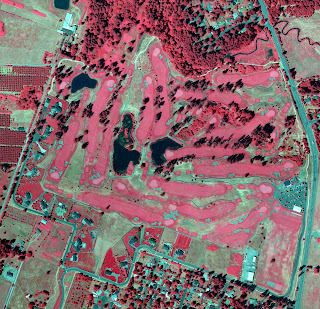Course Conditions
 Last weekend brought our first good storm of the fall season. Not only did we receive close to two inches of rain we received quite a bit of wind as well. Once the sun comes up I will get my first good look at the course to see how it weathered. Adam sent me this picture of the pump house. It looks like the roof took a shot through the eve. A loose branch was hiding up in the firs and decided to come down with the wind. A little bit further and the meter could have been damaged. This is a good example of why our ongoing tree program is so vital. This grove has been neglected since it was not in play. You can count on it getting some attention this winter.
Last weekend brought our first good storm of the fall season. Not only did we receive close to two inches of rain we received quite a bit of wind as well. Once the sun comes up I will get my first good look at the course to see how it weathered. Adam sent me this picture of the pump house. It looks like the roof took a shot through the eve. A loose branch was hiding up in the firs and decided to come down with the wind. A little bit further and the meter could have been damaged. This is a good example of why our ongoing tree program is so vital. This grove has been neglected since it was not in play. You can count on it getting some attention this winter.With the recent rain and the wet forecast this week chances are that we will be restricting the carts to the paths. We managed to complete all the fall cultural chores last week and are now focusing on hitting the details. We are still mowing quite a bit. We had one good frost early last week but that wasn't enough to completely put the breaks on the growth. The bunkers have all been trimmed but now appears that we could go back and hit the ones on four and seven again.
Sunday afternoon I was picking up Adam from work and noticed this cart that came in late in the day. Obviously it was out in the conditions and it didn't look to good. It appears the wind is blowing the side curtains so hard that it is blowing them clean off the mounts. Miles said he found three carts in this condition in the two hours that he had been working when I spoke to him. Adam said one came in earlier. We may need to make some adjustments so this doesn't continue to happen.
Jason and Rick are moving right along on the fifteen cart path project. If the weather cooperates today they are hoping to pour the second phase of the concrete walls. If we can get it done there is a good chance we could make the final pour on Wednesday, which is the only good day in the forecast this week. I really like how the new path is going to look. I don't think we will be having any more mishaps after this is done.
Oregon's Golf Economy
Last Wednesdays Oregon's Golf Economy Media Day, which was held at Stone Creek, was a great event. It is good to know that Oregon's golf economy is estimated at $1.2 billion and contributes more than 27,000 jobs and has a total impact of over $2.5 billion annually.
Dr. Peter Ryan of the Stanford Research Institute International provided the details of the study. He said "The importance of golf in Oregon extends beyond the golf facilities themselves. With $1.2 billion of of direct economic activity in 2008, the sheer size of the game of golf makes it a major industry in its own right and a significant contributor to Oregon's economy."
| Greg Lyman, GCSAA |
Superintendents associations across the country have been supporting their perspective turfgrass programs through donations from superintendents themselves and much of it comes from the allied industry such as Toro, Jacobsen and John Deere. This is no different in Oregon. We happen to live in the grass seed capital of the world and are in position to grow the turf program at OSU to where it will become the leading program on the west coast. We just recently hired Dr. Rob Golembieski to take Tom Cooks position following his retirement. Rob has spring boarded the program from what Tom had built and is poised to take the program further than before. All the program needs is financial support. The Oregon State Turf Program is headed in a direction that will only make our golf courses better by providing pertinent research that superintendents can utilize to save money and help make their properties operate in a more sustainable manner. At the same time Rob will continue the fine tradition of educating qualified future superintendents.
With the economy the way it is, it is getting harder to find that financial help to to sustain turf programs. I wish there could be a way to find dollars outside of the typical giving circle. Can another parts of our industry help provide support? There is a direct connection between the success of our industry and the level of support that Oregon State can receive. Tom Cook started the turf program back in the late 70's. Since then, look how far golf course conditions have improved, it is by no means an accident.
Click here to read the Oregon Golf Economy Summary Report.



